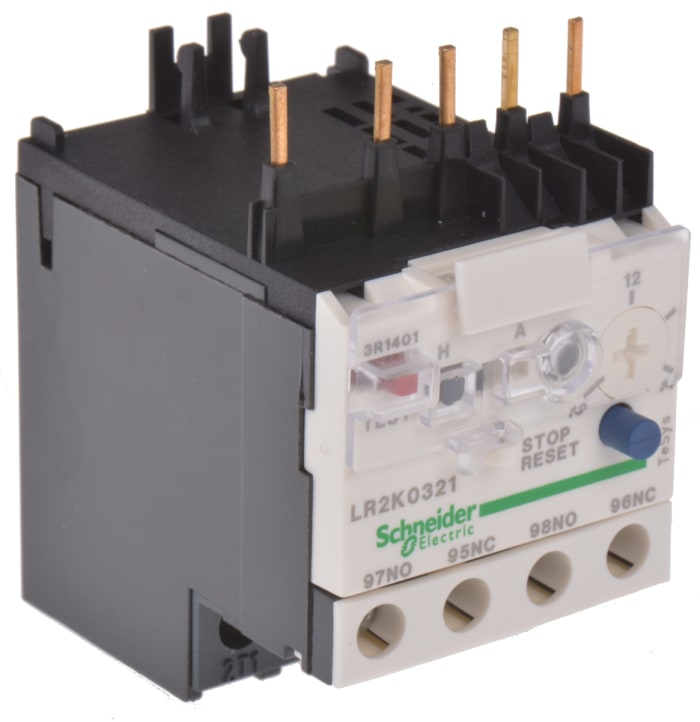Technical Document
Specifications
Brand
Schneider ElectricFLC Motor Rating
12 → 16 A
Contact Current Rating
16 A
Range
TeSys
Series
LR2K
Mounting Style
Clip On
Normal State Configuration
1NO + 1NC
Reset Method
Automatic, Manual
Terminal Type
Screw
Number Of Auxiliary Contacts
2
Width
45mm
Depth
65mm
Length
58mm
Minimum Operating Temperature
-20°C
Maximum Operating Temperature
+55°C
Operating Temperature Range
-20 → +55 °C
Contact Voltage Rating
690 V ac
Control Voltage
250 V dc, 690 V ac
Supply Voltage
250 V dc, 690 V ac
Product details
Schneider Electric Mini Thermal Overload Relays - LR2-K Range
Schneider Electrics K thermal overload relays are adjustable from 0.11 to 11.5 A, they have been predominantly designed for use in applications that require motor protection.
This range of mini thermal overload relays feature compensated and phase failure sensitivity, the range also offers manual and automatic reset. Each overload relay has 3-poles and screw clamp terminals.
Features & Benefits
• Commonly referred to by the range short name - LR2K
• Easy maintenance checks, check the tightening of cables through conducting thermographic testing and checking the mechanical operation of the product through manually operating the test, reset and stop buttons
• Direct mounting under a contactor is achievable
• Standards - IEC 947, BS4941, VDE 0660, NFC63-650
• Standards - CSA, UL, DEMKO, NEMKO, SEMKO, FIMKO, PTB
Applications of a Contactor and Control Overload Relay
• The majority of the time is to protect a motor
• To detect both overload conditions and fault conditions to then announce trip command for a protective device
• To deactivate a device whenever it pulls high current
• Sometimes developed into microprocessor systems and solid-state electronics
SR 316.23
SR 316.23 Each (ex VAT)
SR 363.66
SR 363.66 Each (inc. VAT)
1
SR 316.23
SR 316.23 Each (ex VAT)
SR 363.66
SR 363.66 Each (inc. VAT)
1
Stock information temporarily unavailable.
Please check again later.
Technical Document
Specifications
Brand
Schneider ElectricFLC Motor Rating
12 → 16 A
Contact Current Rating
16 A
Range
TeSys
Series
LR2K
Mounting Style
Clip On
Normal State Configuration
1NO + 1NC
Reset Method
Automatic, Manual
Terminal Type
Screw
Number Of Auxiliary Contacts
2
Width
45mm
Depth
65mm
Length
58mm
Minimum Operating Temperature
-20°C
Maximum Operating Temperature
+55°C
Operating Temperature Range
-20 → +55 °C
Contact Voltage Rating
690 V ac
Control Voltage
250 V dc, 690 V ac
Supply Voltage
250 V dc, 690 V ac
Product details
Schneider Electric Mini Thermal Overload Relays - LR2-K Range
Schneider Electrics K thermal overload relays are adjustable from 0.11 to 11.5 A, they have been predominantly designed for use in applications that require motor protection.
This range of mini thermal overload relays feature compensated and phase failure sensitivity, the range also offers manual and automatic reset. Each overload relay has 3-poles and screw clamp terminals.
Features & Benefits
• Commonly referred to by the range short name - LR2K
• Easy maintenance checks, check the tightening of cables through conducting thermographic testing and checking the mechanical operation of the product through manually operating the test, reset and stop buttons
• Direct mounting under a contactor is achievable
• Standards - IEC 947, BS4941, VDE 0660, NFC63-650
• Standards - CSA, UL, DEMKO, NEMKO, SEMKO, FIMKO, PTB
Applications of a Contactor and Control Overload Relay
• The majority of the time is to protect a motor
• To detect both overload conditions and fault conditions to then announce trip command for a protective device
• To deactivate a device whenever it pulls high current
• Sometimes developed into microprocessor systems and solid-state electronics



